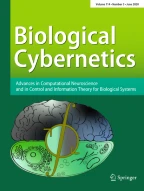Abstract.
In many cases the distribution of saccadic reaction times (SRT) deviates considerably from a unimodal distribution and may often exhibit several peaks. We present a statistical approach to determining the number and form of the individual peaks. The overall density of the reaction times f i (t), i=1…M obtained in M different experiments with the same subject is described as the sum of K basis functions x k (t),k=1…K with different weights and an error term. A change in the experimental conditions is assumed to cause a change in the weights, not in the basis functions. We minimize the square of the difference (measured data minus approximation), divided by the error of the data. Incrementing K step by step we determine the necessary number of basis functions. This method is applied to data of six subjects tested in different saccade tasks. We detect five different modes: two in the range 80–140 ms (express modes), two in the range 145–190 ms (fast-regular mode) and one at about 230 ms (slow-regular mode). These modes are located at about the same positions for different subjects. The method presented here not only proves statistically the existence of several modes in SRT distributions but also allows the distributions to be described by a few characteristic numbers that go beyond the mean values and standard deviations.
Similar content being viewed by others
Author information
Authors and Affiliations
Additional information
Received: 24 March 1997 / Accepted: 5 December 1997
Rights and permissions
About this article
Cite this article
Gezeck, S., Timmer, J. Detecting multimodality in saccadic reaction time distributions in gap and overlap tasks. Biol Cybern 78, 293–305 (1998). https://doi.org/10.1007/s004220050434
Issue Date:
DOI: https://doi.org/10.1007/s004220050434
